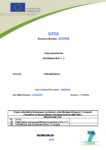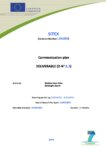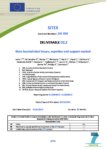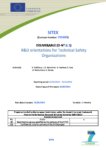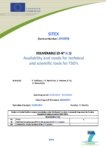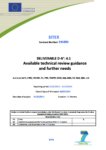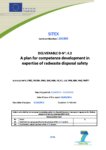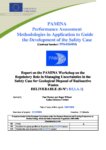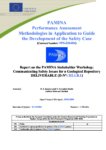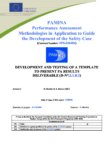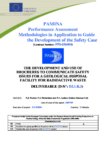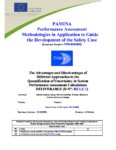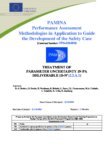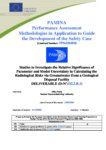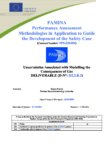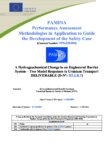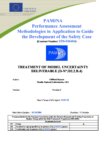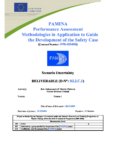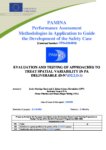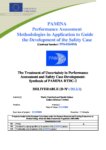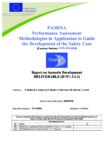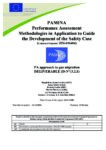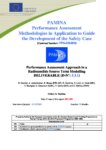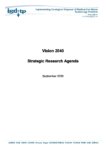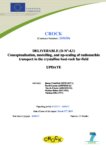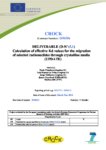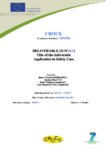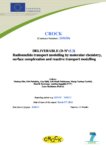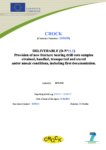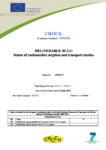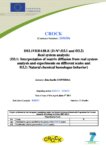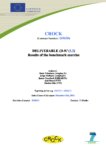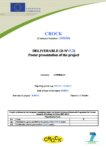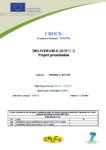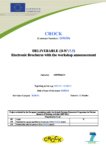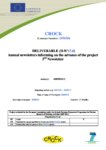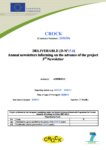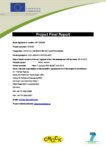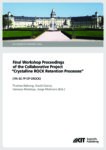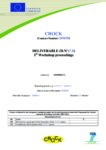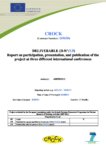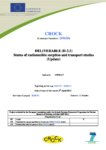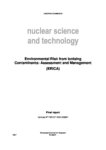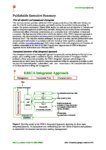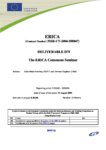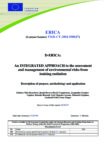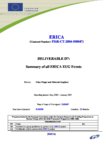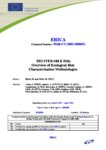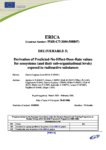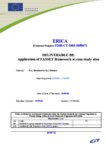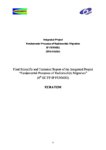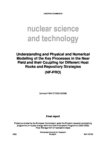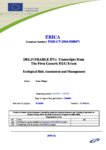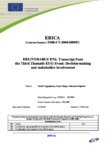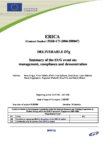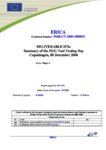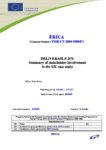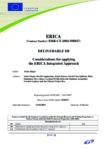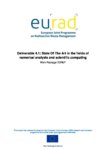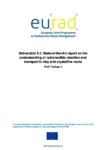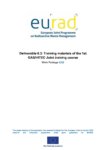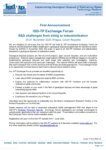Key Topic 1: Post-closure Safety Case
Overview
The purpose of the safety case is to gather all the scientific and technical arguments and evidence required to robustly support the safety claims of disposal facilities and systems. Safety is demonstrated by providing clear reasoning based on sound scientific and technological principles [i]. The safety case should be both robust and easily understandable. Moreover, the safety case sets out the arguments and evidence seeking approval of the licensing documentation for specific nuclear waste disposal facilities and must therefore comply with the various requirements set out by the relevant national authorities. Attention should also be devoted to recommendations suggested by international organisations such as the IAEA and the OECD/NEA.
The safety case must describe the evolution of the repository in such a way that it provides a reasonable representation of the events that might occur, and that also provides a clear indication of the uncertainties included in the description. This topic covers safety case and safety assessment issues related to the evaluation of the radiological impact of the whole repository on humans and the environment, and includes the evolution of the site over geological timescales (e.g. assessing the impact of processes such as erosion and climate change). The impact of the repository and its components are covered under Key Topic 3.
[i] OECD/NEA (2004). Post-closure safety case for geological repositories, Nature and purpose, NEA No. 3679, 2004.
Objective
The objectives of the research area, all of which are related to the “Safely Operate” pillar of the IGD-TP’s Vision 2040, are to:
- Develop a broad view on the basis of the results of long-term safety assessments and enhance confidence in the concepts and the scenarios presented, thereby supporting development of the scope and content of subsequent safety cases for all IGD-TP participants.
- Develop and refine the concepts and models applied to improve long-term safety assessments.
- Improve the way in which sensitivities and uncertainties are addressed and communicated.
- Further improve dialogue and engagement with the relevant authorities and other stakeholders.
Related Documents
Cebama 2016 D4.09 Basis for application to Safety Case and Performance Assessment
Description: Cebama deliverable D4.09, published January 2017. This report series aims at interpreting how the results of the research conducted within CEBAMA can be applied and contribute to the Safety Case. This is the first of two reports, which will be updated at the end of the project. Given the complexity of the experiments and the models developed within CEBAMA, it is in general too early at PM18 for the partners to produce results directly applicable to the Safety Case. Nevertheless, we present here some briefing on the impact aimed at within the project and highlight the value of some of the work undertaken to date.
Last updated: January 20, 2017
CAST 2016 D6.1 C14 in safety assessments
Description: CAST - The first phase of WP6, prior the analysis of the experimental results delivered by the project, aims at taking stock of the C-14 knowledge from the angle of safety assessments. Deliverable D6.1 gives an overview on this for each national program. On the basis of this compilation, commonalities and differences between disposal concepts regarding the impact of the uncertainties linked to C-14 release from radioactive waste disposal will be identified as well as the way to cope with them. This thorough discussion will be the object of deliverable D6.2.
Last updated: January 23, 2016
CAST 2017 D6.2 Knowledge supporting safety assessments of 14C
Description: CAST - Work Package 6 of the CAST project is devoted to the knowledge base concerning the re-lease and transport of 14C in the context of post-closure safety assessments of the geological disposal of radioactive waste. This report (D6.2) assesses the various approaches for safety assessment discussed in report D6.1 in the light of the existing knowledge about the 14C source term. It proposes a synthesis of D6.1, identifies commonalities and differences between approaches and concepts and highlights safety-critical uncertainties pertaining to 14C fate in waste disposal.
Last updated: July 23, 2017
SITEX 2013 D1.1 Project Presentation
Description: SITEX 2013, project deliverable D1.1, Project Presentation
Last updated: February 20, 2019
SITEX 2013 D1.2 Communication Plan
Description: SITEX 2013, project deliverable D1.2, Communication Plan
Last updated: February 20, 2019
SITEX 2013 D2.2 Main key technical issues, expertise and support needed
Description: SITEX 2013, project deliverable D2.2, Main key technical issues, expertise and support needed
Last updated: February 20, 2019
SITEX 2013 D5.1 Recent approaches for stakeholder involvement
Description: SITEX 2013, project deliverable D5.1, Recent approaches for stakeholder involvement
Last updated: February 20, 2019
SITEX 2014 D2.1 Overview of Existing Technical Guides and Further Development
Description: SITEX 2014, project deliverable D2.1, Overview of Existing Technical Guides and Further Development
Last updated: February 20, 2019
SITEX 2014 D3.1 R&D Orientations for Technical Safety Organizations
Description: SITEX 2014, project deliverable D3.1, R&D Orientations for Technical Safety Organizations
Last updated: February 20, 2019
SITEX 2014 D3.2 Availability and needs for technical and scientific tools for TSOs
Description: SITEX 2014, project deliverable D3.2, Availability and needs for technical and scientific tools for TSOs
Last updated: February 20, 2019
SITEX 2014 D3.3 Strategy for implementing TSO`s R&D programmes
Description: SITEX 2014, project deliverable D3.3, Strategy for implementing TSO`s R&D programmes
Last updated: February 20, 2019
SITEX 2014 D4.1 Available technical review guidance and further needs
Description: SITEX 2014, project deliverable D4.1, Available technical review guidance and further needs
Last updated: February 20, 2019
SITEX 2014 D4.2 A plan for competence development in expertise of radwaste disposal safety
Description: SITEX 2014, project deliverable D4.2, A plan for competence development in expertise of radwaste disposal safety
Last updated: February 20, 2019
SITEX 2014 D5.2 Interaction with stakeholders in the technical review in practice
Description: SITEX 2014, project deliverable D5.2, Interaction with stakeholders in the technical review in practice
Last updated: February 20, 2019
SITEX 2014 D6.1 Conditions for establishing a sustainable expertise network
Description: SITEX 2014, project deliverable D6.1, Conditions for establishing a sustainable expertise network
Last updated: February 20, 2019
SITEX 2014 D6.2 Terms of Reference (TOR) of the SITEX network
Description: SITEX 2014, project deliverable D6.2, Terms of Reference (TOR) of the SITEX network
Last updated: February 20, 2019
PAMINA Deliverable D1.1.1 – Task reports for the first group of topics
Last updated: October 8, 2019
PAMINA Deliverable D1.1.3 – Task reports for the third group of topics
Last updated: October 8, 2019
PAMINA Deliverable D2.1.B.2 – Development and Testing of a Template to Present PA Results
Last updated: October 8, 2019
PAMINA Deliverable D2.1.D.1 – Evaluation of Approaches to Sensitivity Analysis
Last updated: October 8, 2019
PAMINA Deliverable D2.2.A.1 – Treatment of Parameter Uncertainty in PA
Last updated: October 8, 2019
PAMINA Deliverable D2.2.B.2 – Uncertainties Associated with Modelling the Consequences of Gas
Last updated: October 11, 2019
Last updated: October 11, 2019
Description: Deliverables from WP4 of the PAMINA Project: D4.1.1, D4.1.2, D4.1.3, D4.2.1, D4.2.2, D4.2.4 and D4.3.1.
Last updated: October 11, 2019
PAMINA Deliverable D3.3.1 – Performance Assessment Approach in a Radionuclide Source Term Modelling
Last updated: October 11, 2019
Last updated: October 11, 2019
PAMINA Deliverable D3.4.2 – Safety Indicators and Performance Indicators
Last updated: October 11, 2019
Description: Milestones from the PAMINA Project: MS1.2.1, MS2.1.c.1, MS2.1.c.2, MS2.1.c.3, MS2.1.d.11, MS2.1.d.4, MS2.1.d.5, MS2.1.d.8, MS2.2.a.12, MS2.2.a.3, MS2.2.a.4, MS2.2.c.2, MS2.2.c.3, MS2.2.d.1, MS2.2.d.2, MS2.2.d.4, MS2.2.e.2, MS2.2.e.3, MS2.2.e.5, MS3.2.14, MS3.2.16 and MS3.4.19.
Last updated: October 11, 2019
IGD-TP Vision 2040 and Strategic Research Agenda
Description: IGD-TP Vision 2040 and Strategic Research Agenda, published September 2020 (reference error corrected on 26/09/2022)
Last updated: October 7, 2020
CROCK D4.1 WP4 Month 12 progress
Description: CROCK Deliverable 4.1, Progress report for WP4 at Month 12.
Last updated: December 14, 2021
CROCK D4.1 WP4 month 27 progress report
Description: Update to D4.1 of the CROCK project outlining progress in WP4 as of month 27 of the project.
Last updated: December 15, 2021
CROCK D5.1 WP5 month 27 progress report
Description: Update to D5.1 of the CROCK project outlining progress in WP5 as of month 27 of the project.
Last updated: December 15, 2021
CROCK D5.1 WP5 month 12 progress report
Description: Deliverable 5.1 of the CROCK project outlining progress in WP5 as of month 12 of the project.
Last updated: December 15, 2021
Description: Deliverable 5.3 of the CROCK project: Radionuclide transport modelling by molecular chemistry, surface complexation and reactive transport modelling.
Last updated: December 15, 2021
Description: Deliverable 1.1 of the CROCK project: Provision of new fracture bearing drill core samples obtained, handled, transported and stored under anoxic conditions, including first documentation.
Last updated: December 15, 2021
CROCK D1.2- Characterization of experimental material.
Description: CROCK D1.2- "Characterization of experimental material", detailing characterization of the new samples of fracture crystalline rock drill-cores from the Äspö URL, sampled and handled under anoxic conditions.
Last updated: December 15, 2021
CROCK Deliverable 2.1- Status of radionuclide sorption and transport studies
Description: Deliverable D2.1 of the CROCK project outlining progress against WP2 (radionuclide sorption and transport studies) as of July 2012.
Last updated: December 15, 2021
CROCK D3.1 and D3.2- Real system analysis
Description: Deliverable 3.1 and 3.2 of the CROCK project, report supplying all relevant background sources of the analytical and field pore water data, together with interpretations, from the Swedish site characterisation programme with a focus on matrix diffusion.
Last updated: December 15, 2021
Description: Update to Deliverable 3.1 and 3.2 of the CROCK project for month 27 of the CROCK project.
Last updated: December 15, 2021
CROCK D5.2- Results of the benchmark exercise.
Description: CROCK Project Deliverable 5.2- Results of the benchmark exercise aimed at assessing the potential release of a set of radionuclides at repository depth and the related migration and discharge at the surface.
Last updated: December 15, 2021
CROCK D7.1- Establishing and regularly updating public web portal and project internal intranet site
Description: Deliverable 7.1 of the CROCK project- Establishing and regularly updating public web portal and project internal intranet site
Last updated: December 15, 2021
CROCK Deliverable D7.2- Poster presentation of the project
Description: CROCK Deliverable D7.2- Poster presentation of the project
Last updated: December 15, 2021
CROCK D7.3- Project presentation
Description: CROCK D7.3- A short presentation on the project.
Last updated: December 15, 2021
CROCK D7.5 – Brochure for the 1st CROCK workshop May 2012
Description: CROCK D7.5 - Brochure for the 1st CROCK workshop May 2012
Last updated: December 15, 2021
CROCK D7.5- Brochure for the last CROCK workshop, May 2013
Description: CROCK deliverable 7.5- Brochure for the last CROCK workshop, May 2013
Last updated: December 15, 2021
CROCK D7.6-2nd annual newsletter
Description: CROCK D7.6- 2nd annual CROCK newsletter
Last updated: December 15, 2021
CROCK D7.2- 3rd annual newletter
Description: CROCK D7.2- 3rd annual newletter
Last updated: December 15, 2021
Description: Final report for the Collaborative Project Crystalline ROCK retention processes (CP CROCK) project. A project with the overall objective to develop a methodology for decreasing the uncertainty in the long-term prediction of the radionuclide migration in the crystalline rock repository far-field.
Last updated: December 15, 2021
Description: Proceedings of the CROCK project final workshop (May 2013). KIT-SR 7656
Last updated: December 15, 2021
CROCK D7.8 – Proceedings of the 1st workshop of the CROCK project
Description: The proceedings of the 1st Workshop of the EURATOM FP7 Collaborative Project CROCK (Crystalline Rock Retention Processes).
Last updated: December 15, 2021
Description: Deliverable 7.9 of the CROCK project - Report on participation, presentation, and publication of the project at three different international conferences
Last updated: December 15, 2021
CROCK D2.1 – Status of radionuclide sorption and transport studies (Update)
Description: Deliverable 2.1 of the CROCK project, progress report for WP2 (month 27): "Status of radionuclide sorption and transport studies (Update)"
Last updated: December 15, 2021
Description: Final report of the Environmental Risk from Ionising Contaminants: Assessment and Management (ERICA) project.
Last updated: January 18, 2022
Description: This summary reviews activities within the ERICA project at the time of the Mid-Term Review, i.e. after 18 of the 36 months project duration.
Last updated: January 24, 2022
ERICA – D7f: The ERICA Consensus Seminar
Description: Deliverable D7f of the ERICA project - Report on the ERICA EUG Consensus Seminar (held in Stavern, June 27th – 30th 2006).
Last updated: January 24, 2022
Description: The D-ERICA report, which summarises the developments in the ERICA project and describes the ERICA Integrated Approach to the assessment and management of environmental risks from ionising radiation.
Last updated: January 24, 2022
ERICA – D7: Summary of all ERICA EUG Events
Description: Deliverable 7 of the ERICA project - Summary of all ERICA EUG Events.
Last updated: January 24, 2022
ERICA – D4b: Overview of Ecological Risk Characterisation Methodologies
Description: Deliverable D4b of the ERICA project - "Overview of Ecological Risk Characterisation Methodologies"
Last updated: January 24, 2022
Description: Deliverable D5 of the ERICA project - "Derivation of Predicted-No-Effect-Dose-Rate values for ecosystems (and their sub-organisational levels) exposed to radioactive substancess"
Last updated: January 24, 2022
ERICA – D9: Application of FASSET framework at case study sites
Description: Deliverable 9 of the ERICA project - "Application of FASSET framework at case study sites"
Last updated: January 24, 2022
FUNMIG – Final Scientific and Technical Report
Description: Final Scientific and Technical Report of the Integrated Project “Fundamental Processes of Radionuclide Migration” (FUNMIG).
Last updated: January 27, 2022
Description: The final report of the NF-PRO project (Understanding and Physical and Numerical Modelling of the Key Processes in the Near-Field and their Coupling for Different Host Rocks and Repository Strategies).
Last updated: February 11, 2022
ERICA – D7c: Transcripts from The First Generic EUG Event Ecological Risk Assessment and Management
Description: Deliverable 7c of the ERICA project - "Transcripts from The First Generic EUG Event Ecological Risk Assessment and Management"
Last updated: February 7, 2022
Description: Deliverable 7d of the ERICA project - "Transcript from the Third Thematic EUG Event: Decision-making and stakeholder involvement"
Last updated: February 7, 2022
ERICA – D7e: Scientific Uncertainties: Transcript from the EUG Workshop
Description: Deliverable 7e of the ERICA project - "Scientific Uncertainties: Transcript from the EUG Workshop."
Last updated: February 7, 2022
ERICA – D7g: Summary of the EUG event on: management, compliance and demonstration
Description: Deliverable 7g of the ERICA project - "Summary of the EUG event on: management, compliance and demonstration."
Last updated: February 7, 2022
ERICA – D7h: Summary of the EUG Tool Testing Day Copenhagen, 08 December 2006
Description: Deliverable 7h of the ERICA project - "Summary of the EUG Tool Testing Day Copenhagen, 08 December 2006."
Last updated: February 7, 2022
ERICA – D7i: Summary of stakeholder involvement in the UK case study
Description: Deliverable 7i of the ERICA project - "Summary of stakeholder involvement in the UK case study."
Last updated: February 7, 2022
ERICA – D8: Considerations for applying the ERICA Integrated Approach
Description: Deliverable 8 of the ERICA project - "Considerations for applying the ERICA Integrated Approach"
Last updated: February 7, 2022
EURAD/ACED D2.4: Treatment of chemical evolutions in national programmes
Description: EURAD/ACED Deliverable 2.4: "Treatment of chemical evolutions in national programmes"
Last updated: June 16, 2022
EURAD/DONUT D4.1: State Of The Art in the fields of numerical analysis and scientific computing
Description: EURAD/DONUT Deliverable 4.1: "State Of The Art in the fields of numerical analysis and scientific computing"
Last updated: June 16, 2022
Description: EURAD Deliverable 5.1: "State-of-the-Art report on the understanding of radionuclide retention and transport in clay and crystalline host rocks"
Last updated: June 16, 2022
EURAD/GAS D6.1: Initial State of the Art on Gas Transport in Clayey Materials
Description: EURAD/GAS Deliverable 6.1: "Initial State of the Art on Gas Transport in Clayey Materials"
Last updated: June 16, 2022
EURAD/GAS D6.3: Training Materials of the 1st GAS/HITEC joint training course
Description: EURAD/GAS Deliverable 6.3: "Training Materials of the 1st GAS/HITEC joint training course"
Last updated: June 16, 2022
BEACON D1.1: State-of-the-Art Report
Description: BEACON (Bentonite Mechanical Evolution) Deliverable 1.1: State-of-the-Art Report
Last updated: July 19, 2022
BEACON D1.3: Final Assessment Report
Description: BEACON (Bentonite Mechanical Evolution) Deliverable 1.3: Final Assessment Report
Last updated: July 19, 2022
BEACON D2.2: Database of experimental data
Description: BEACON (Bentonite Mechanical Evolution) Deliverable 2.2: Database of experimental data
Last updated: July 19, 2022
Description: BEACON (Bentonite mechanical evolution) Deliverable 2.3: Identification of captured knowledge of bentonite mechanical evolution gained over the duration of the Beacon project
Last updated: July 19, 2022
BEACON D3.1: Description of the constitutive models available at the start of the project
Description: BEACON (Bentonite mechanical evolution) Deliverable 3.1: Description of the constitutive models available at the start of the project.
Last updated: July 19, 2022
BEACON D3.3: Description of the constitutive models developed in the project
Description: BEACON (Bentonite Mechanical Evolution) Deliverable 3.3: Description of the constitutive models developed in the project. Conceptual bases, mathematical description and model capabilities. Assessment of predictive power
Last updated: July 19, 2022
BEACON D4.1: Experimental work for the support of model development and validation
Description: BEACON (Bentonite Mechanical Evolution) Deliverable 4.1: Experimental work for the support of model development and validation
Last updated: July 19, 2022
BEACON D4.3: Experimental work on bentonite evolution in the frame of BEACON – final report of WP4
Description: BEACON (Bentonite Mechanical Evolution) Deliverable 4.3: Experimental work on bentonite evolution in the frame of BEACON – final report of WP4
Last updated: July 19, 2022
Description: BEACON (Bentonite Mechanical Evolution) Deliverable 5.1.1: Specifications for Beacon WP5: testing, verification and validation of models step 1- verification cases
Last updated: July 19, 2022
BEACON D5.1.2: Synthesis of results from task 5.1
Description: BEACON (Bentonite Mechanical Evolution) Deliverable 5.1.2: Synthesis of results from task 5.1
Last updated: July 19, 2022
Description: BEACON (Bentonite Mechanical Evolution) Deliverable 5.2.1: Specifications for Beacon WP5: testing, verification and validation of models step 2- large scale experiments
Last updated: July 19, 2022
BEACON D5.2.2: Synthesis of the results obtained of test cases from task 5.2
Description: BEACON (Bentonite Mechanical Evolution) Deliverable 5.2.2: Synthesis of the results obtained of test cases from task 5.2
Last updated: July 19, 2022
Description: BEACON (Bentonite Mechanical Evolution) Deliverable 5.5: Specifications for Beacon WP5: testing, verification and validation of models step 3- predictive test cases
Last updated: July 19, 2022
BEACON D5.6: Synthesis of the results obtained of test cases from task 5.3
Description: BEACON (Bentonite Mechanical Evolution) Deliverable 5.6: Synthesis of the results obtained of test cases from task 5.3
Last updated: July 19, 2022
BEACON D5.7: Synthesis of the results obtained of test cases from all tasks
Description: BEACON (Bentonite Mechanical Evolution) Deliverable 5.7: Synthesis of the results obtained of test cases from all tasks
Last updated: July 19, 2022
Description: BEACON (Bentonite Mechanical Evolution) Deliverable 6.2: Civil society perspectives with a focus on verification and validation of models, and comparing models with situations close to disposal conditions (task 5.1 and 5.2 of WP5)
Last updated: July 19, 2022
BEACON D7.2: Project presentation. Nature, scope, activities and expected results of the project
Description: BEACON (Bentonite Mechanical Evolution) Deliverable 7.2: Project presentation. Nature, scope, activities and expected results of the project
Last updated: July 19, 2022
BEACON D7.3: Beacon Plan for the Exploitation and Dissemination of Results
Description: BEACON (Bentonite Mechanical Evolution) Deliverable 7.3: Beacon Plan for the Exploitation and Dissemination of Results
Last updated: July 19, 2022
BEACON D8.1: Beacon Data Management Plan
Description: BEACON (Bentonite Mechanical Evolution) Deliverable 8.1: Beacon Data Management Plan
Last updated: July 19, 2022
BEACON D2.1: Initial workshop materials
Description: BEACON (Bentonite Mechanical Evolution) Deliverable 2.1: Initial workshop materials
Last updated: July 19, 2022
IGD-TP Exchange Forum 2025 – First Announcement
Description: IGD-TP Exchange Forum 2025 - First Announcement (issued 14 March 2025, revised 13 April 2025)
Last updated: March 14, 2025
IGD-TP Exchange Forum 2025 – Second Announcement and Call for Posters
Description: IGD-TP Exchange Forum 2025 - Second Announcement and Call for Posters (issued 2 June 2025)
Last updated: June 2, 2025
2025-11 IGD-TP Exchange Forum – Programme and Abstracts
Description: IGD-TP Exchange Forum 2025, Programme and Abstracts, November 2025 (v2)
Last updated: November 3, 2025
Related Activities

BELBaR

FIRST-Nuclides

SITEX
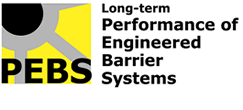
PEBS

FORGE

PAMINA

CROCK

ERICA
ARGONA

FUNMIG
NF-PRO
COWAM In Practice
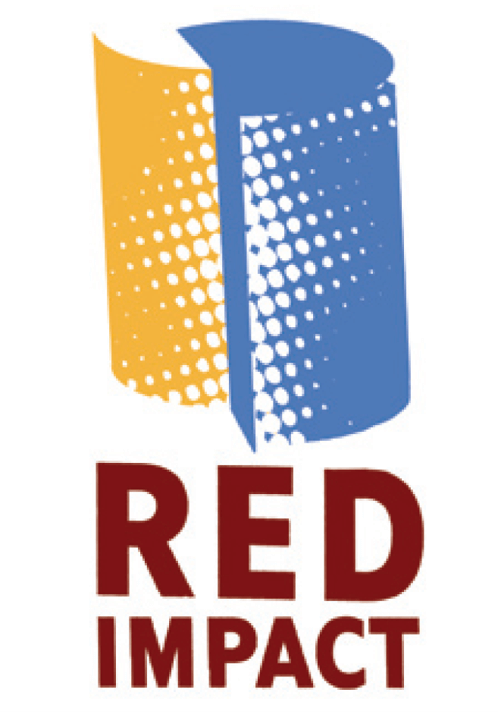
RED-IMPACT

KiNa

CCSC






